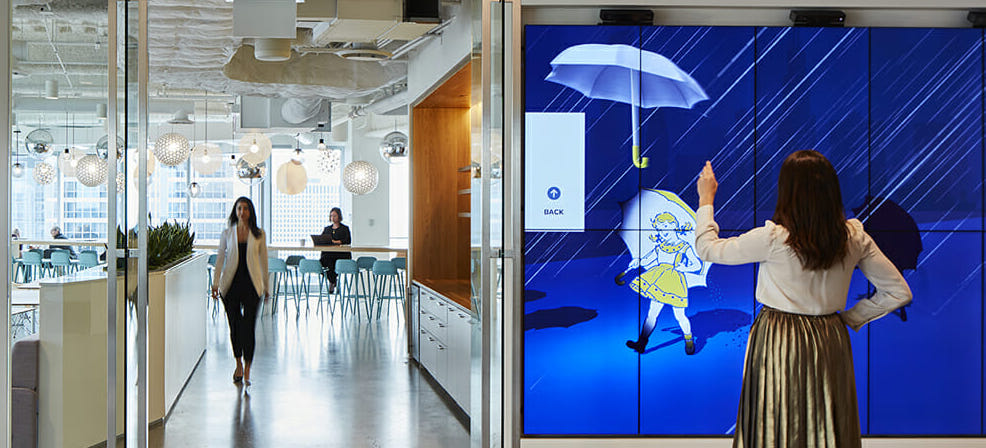
Morton Salt Using Gesture-Driven Video Wall To Tell Company Story At New HQ Digs
August 19, 2022 by Dave Haynes
When the biggest producer and marketer of salt – for dining all the way to de-icing – moved its 350 or so staffers to new digs in downtown Chicago, the CEO wanted something at the reception area that digitally told the company story and reflected its marketing initiatives.
Morton Salt went with a gesture-driven LCD video video wall that sits just to the right of the entry doors and the check-in counter, using sensors to capture movements and respond with designated content pieces.
Big AV integrator Diversified put the system in, working with creative partner, VisionThree. Says a brief:
” … the Diversified team developed a custom gesture-controlled, interactive portrait video wall. The wall is comprised of 12 HD video displays, powered by three Microsoft Kinect motion sensors, and invites passing associates and visitors to step forward and reach toward the wall. From the main menu, users can choose to explore the different methods of salt production, watch the newest marketing videos, and see the evolution of the Morton Salt girl. The interface is simple, intuitive and beautifully crafted.
The whole system was built from scratch. “We’d never done anything quite like this,” said Jeff White of VisionThree. “It took us a month to build the gesture controls alone. You wouldn’t imagine all the ways that people point.”
The outcome of all this hard work is the creation of a true centerpiece for an already impressive office. On the first day at the new location, associates and visitors stopped to interact with the video wall as soon as they entered the lobby. After watching his associates interact with the wall, and trying it out himself, (Morton CEO Christian) Herrmann said that he was extremely pleased with the display: “Everyone who’s coming here—vendors, contractors, clients, even new associates—are learning about what Morton stands for.”
Interesting. I thought Kinect was a dead product, but that’s on the consumer side. There is a developer kit for much more involved, AI-centric sensor applications, tied to Microsoft Azure.
I think gesture-driven experiences are bad ideas in busy public spaces, and particularly bad if people need to wait in line to use them, and the people ahead are struggling with getting the gestures down.
But in this sort of environment, where visitors may have time to kill as they wait for their host to come to reception, this set-up would be fine (though I wonder how much it gets used after the honeymoon/novelty period). Touchscreen surfaces like this are not thought to be particularly risky for transferring pathogens between people, but I suppose a gesture-based system removes the risk entirely. It also allows people to navigate without walking up, boinking the screen, and then stepping back to take it all in.
https://youtu.be/gUsXEDO1ycg



Leave a comment